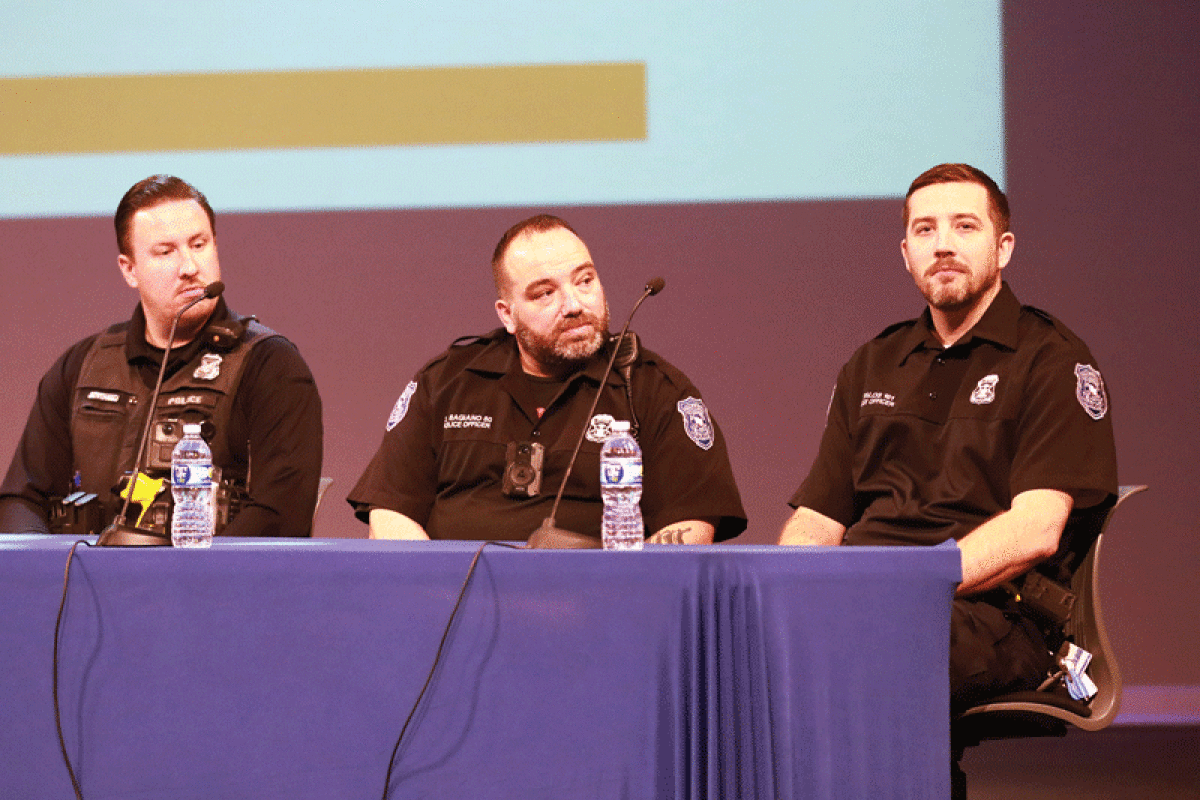STERLING HEIGHTS/WARREN — Sterling Heights Police officer Duane Casbar has a message for students who post prank threats against schools on social media.
They could face criminal charges for their actions.
“There could be fines or a year in juvenile jail. It could be a year on probation, a 10-year jail sentence, or a $20,000 fine. It is ultimately up to the judge,” said Casbar, also the Sterling Heights High School resource officer.
Casbar was among a panel of school personnel at the teen vaping awareness and social media consequences workshop Warren Consolidated Schools held March 7 in the Sterling Heights High School Performing Arts Center.
“A lot of these (pranks) get sent out at night. Now we’re getting multiple calls at 11 o’clock at night and we have to start our investigation. We want to make sure we can solve it before school starts,” Casbar said. “Some of the kids, they think it’s funny. It’s not funny at all. We have to take everything seriously.”
Students also can get into trouble if they forward prank school threats on social media to their friends and classmates.
“If you forward it, now you’re creating a panic,” Casbar said.
Casbar shared the stage with guest speakers Natalia Waske, of CARE of Southeastern Michigan; Warren Mott High School counselors Candice Erickson and Alecia West; and Warren Police officers Darryl Bagiano and John Talos. Bagiano is the Warren Mott High School resource officer, and Talos is the Cousino High School resource officer.
CARE of Southeastern Michigan offers services and programs that focus on substance abuse prevention; parenting; teen outreach and services; mental and emotional health; and other areas vital to personal and community well-being.
“Over the past year, I have spoken with many parents who are simply overwhelmed because their children are addicted to vaping and using social media,” district Superintendent Robert Livernois said. “I hope the event brings forward a continued conversation about this. We truly love our kids and we want them to be successful and healthy. I think the biggest prevention in our schools is to help our parents understand what to look for. It’s a place to start. There’s that fine line in wanting to trust your children and wanting to protect them.”
The district has endured several social media prank threats this school year. One suggestion from the panel is for parents to conduct random cellphone checks with their children.
“There are different apps out there and you can monitor your kids,” Casbar said. “You can restrict their apps. Parents that say, ‘Oh, my kids would never do this,’ I can guarantee that’s the kid that’s doing it.”
Students are reminded that if they hear about any potential threats they should contact school personnel immediately or their local police department. Bagiano also advised contacting the OK2SAY program at michigan.gov/ok2say. OK2SAY allows anyone to confidentially report tips on criminal activities or potential harm directed at Michigan students, school employees or schools without having to give their name.
“It’s anonymous and it’s worked well in the past,” Bagiano said.
‘Vaping is the smoking of teens now.’
During the vaping portion of the workshop, Waske provided a PowerPoint presentation that detailed the dangers of vaping, which is the inhaling of a vapor created by an electronic cigarette or other vaping device. She started her presentation pointing out the various chemicals in vaping products, including nicotine, xylene, styrone, pyrene, benzene, acetone and sulfur.
“Ultimately, these are things we don’t want to be putting in our lungs,” Waske said.
Waske displayed a chart that explained how nicotine leads to addiction.
“Nicotine rewards the brain by releasing dopamine, the ‘feel good’ chemical. When nicotine wears off, the brain craves more,” the chart stated. “The brain learns to depend on nicotine to regulate mood and cause addiction.”
Kids try vaping for many reasons, including curiosity and peer pressure.
“Vaping is the smoking of teens now. We don’t really see cigarettes anymore,” Bagiano said. “There are vaping pens. They come in all kinds of shapes and sizes. Some (kids) charge them in their laptops.”
“People (vape) when they are stressed,” Waske said. “Using vape increases the risk of future addiction to other drugs.”
According to Waske’s presentation, vaping is linked to bronchitis, chest pains, coughing, headaches, insomnia and more. She also showed images of colorful advertisements on vaping products that target kids.
Regarding the teens who vape, parents need to ask the question, “Why does my son or daughter vape?” Erickson said.
Waske is among the CARE representatives who works with students that have either quit vaping or are making the attempt.
“The person who is smoking must be ready to quit. There is peer support,” Waske said. “We meet and learn different coping skills, and how to stand up to their peers and be firm.”
Tonya and Bryan Hudson, whose daughter attends Sterling Heights High School, were among the parents who attended the workshop.
“It’s a very strong topic. I think there’s a need in the community,” Tonya Hudson said. “We as parents need to know what’s out there. We need to keep our eyes and ears open about it.”
“I think (vaping) is part of a subculture,” Bryan Hudson said. “The students who are using have their own subculture.”
The colorful packaging on vaping products really opened his eyes.
“When I think about nicotine, I don’t think about products that look like candy,” he said. “That’s almost an attack on our youth. We have the chance to protect them from it.”
For more information on CARE of Southeastern Michigan; visit careofsem.com.
 Publication select ▼
Publication select ▼



















